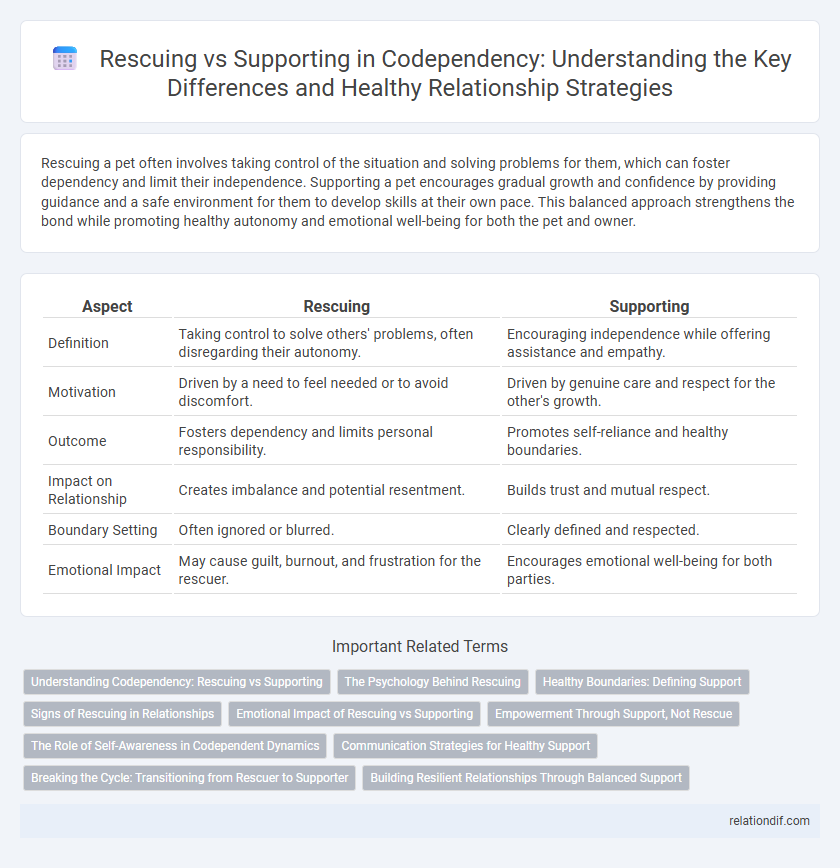Rescuing a pet often involves taking control of the situation and solving problems for them, which can foster dependency and limit their independence. Supporting a pet encourages gradual growth and confidence by providing guidance and a safe environment for them to develop skills at their own pace. This balanced approach strengthens the bond while promoting healthy autonomy and emotional well-being for both the pet and owner.
Table of Comparison
| Aspect | Rescuing | Supporting |
|---|---|---|
| Definition | Taking control to solve others' problems, often disregarding their autonomy. | Encouraging independence while offering assistance and empathy. |
| Motivation | Driven by a need to feel needed or to avoid discomfort. | Driven by genuine care and respect for the other's growth. |
| Outcome | Fosters dependency and limits personal responsibility. | Promotes self-reliance and healthy boundaries. |
| Impact on Relationship | Creates imbalance and potential resentment. | Builds trust and mutual respect. |
| Boundary Setting | Often ignored or blurred. | Clearly defined and respected. |
| Emotional Impact | May cause guilt, burnout, and frustration for the rescuer. | Encourages emotional well-being for both parties. |
Understanding Codependency: Rescuing vs Supporting
Understanding codependency involves recognizing the difference between rescuing and supporting, where rescuing often enables unhealthy dependency by solving problems for others, while supporting encourages autonomy and healthy boundaries. Rescuing behaviors can lead to emotional exhaustion and perpetuate dysfunction, whereas supporting fosters self-efficacy and mutual respect in relationships. Identifying these patterns is crucial for breaking codependent cycles and promoting mental health.
The Psychology Behind Rescuing
The psychology behind rescuing in codependency stems from a deep need for validation and control, often rooted in low self-esteem and fear of abandonment. Rescuers typically derive their sense of worth from solving others' problems, which perpetuates dependency rather than fostering autonomy. This behavior can escalate stress and hinder healthy relationship boundaries by prioritizing others' needs over self-care.
Healthy Boundaries: Defining Support
Defining support within codependency involves establishing healthy boundaries that distinguish helping from rescuing, ensuring assistance empowers rather than enables dependency. Healthy support respects autonomy by encouraging problem-solving and self-reliance, while rescuing often overrides personal responsibility and fosters dependency. Clear boundaries promote balanced relationships where support nurtures growth and independence instead of fostering codependent patterns.
Signs of Rescuing in Relationships
Signs of rescuing in relationships include constantly solving problems for others without their input, neglecting personal boundaries to fix issues, and feeling responsible for another person's emotions or actions. This behavior often leads to enabling dependence, where the rescuer prioritizes the other's needs over their own well-being. Recognizing patterns such as unsolicited advice, frequent interference, and emotional exhaustion helps differentiate rescuing from genuine support.
Emotional Impact of Rescuing vs Supporting
Rescuing in codependent relationships often leads to emotional exhaustion, resentment, and reduced self-esteem for both parties, as it fosters dependency and helplessness. Supporting, by contrast, promotes emotional resilience, autonomy, and mutual respect, allowing individuals to develop problem-solving skills and healthy boundaries. The emotional impact of supporting encourages empowerment and growth, whereas rescuing perpetuates a cycle of neediness and emotional imbalance.
Empowerment Through Support, Not Rescue
Empowerment through support emphasizes fostering independence and self-efficacy rather than taking over responsibilities in codependent relationships. Providing encouragement, active listening, and setting healthy boundaries enables individuals to build resilience and confidence. This approach reduces enabling behaviors and promotes sustainable personal growth.
The Role of Self-Awareness in Codependent Dynamics
Self-awareness plays a critical role in distinguishing rescuing behaviors from genuine support in codependent dynamics. Recognizing one's motives helps prevent enabling harmful patterns and fosters healthier boundaries. Developing insight into emotional triggers promotes balanced interactions that empower both parties without fostering dependency.
Communication Strategies for Healthy Support
Effective communication strategies for healthy support emphasize active listening and setting clear boundaries to avoid codependent rescuing behaviors. Encouraging open dialogue allows individuals to express their needs and feelings without judgment, fostering mutual respect and empowerment. Using "I" statements and offering empathy rather than unsolicited solutions promotes resilience and autonomy in relationships affected by codependency.
Breaking the Cycle: Transitioning from Rescuer to Supporter
Breaking the cycle of codependency involves shifting from rescuing behaviors to supportive actions that promote autonomy and growth. Rescuers often take control of others' problems, inadvertently enabling dependency, whereas supporters encourage self-efficacy by setting healthy boundaries and fostering empowerment. This transition requires consistent practice of active listening, patience, and reinforcing individual responsibility within relationships to build balanced interdependence.
Building Resilient Relationships Through Balanced Support
Building resilient relationships requires distinguishing between rescuing and supporting, where supporting empowers individuals to face challenges independently rather than creating dependency. Balanced support fosters trust and growth by encouraging autonomy while providing emotional stability. This approach strengthens bonds and promotes long-term psychological resilience within relationships affected by codependency.
Rescuing vs Supporting Infographic

 relationdif.com
relationdif.com